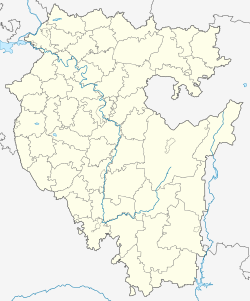Sterlitamak
city
|
||||||||||||||||||||||||||||||||||||||||||
|
||||||||||||||||||||||||||||||||||||||||||
|
||||||||||||||||||||||||||||||||||||||||||
| List of cities in Russia | ||||||||||||||||||||||||||||||||||||||||||
Sterlitamak ( Russian Стерлитама́к , Bashkir Стәрлетамаҡ ) with 273,486 inhabitants (as of October 14, 2010) is the second largest city in the autonomous republic of Bashkortostan in the eastern part of European Russia after Ufa .
geography
Sterlitamak is located on the left bank of the Belaya River and on the western foothills of the Southern Urals , about 130 km south of Ufa and about halfway between Ufa and the administrative border of Bashkortostan and Orenburg Oblast . The two closest cities are Ischimbai (21 km south of Sterlitamak) and Salawat (29 km south).
history
Until the middle of the 18th century there was a post office in the area of today's city on the way between the provincial centers of Ufa and Orenburg . Since salt production was in its heyday in this area at that time , a wholesale merchant had a port built on the Belaja for the distribution of the salt extracted further upstream. Its construction was completed in 1766; thus this year is considered to be the founding year of the city of Sterlitamak. The place name comes from the Bashkir language and literally means “the mouth of the Sterlja [into the Belaja]”.
In 1781, as part of a regional reform, the place was granted city status, and a year later Tsarina Catherine II approved the design for her own Sterlitamaker city coat of arms. The operation of the salt port dominated the town economically until the early 20th century.
From 1919 to 1922 Sterlitamak was the capital of the newly formed Autonomous Soviet Republic of Bashkiria within Soviet Russia , until this status was granted to Ufa. Since 1930 Sterlitamak has been the capital of the republic Rajon of the same name . During the Second World War , several industrial companies were evacuated from the European part of the Soviet Union to Sterlitamak.
In the post-war period, the Sterlitamak industry expanded, which was not least due to the oil production around the city that began in the 1930s . New districts emerged, so that the city passed the 100,000 mark as early as the 1950s. Due to the rapid industrialization, the environmental situation in Sterlitamak deteriorated considerably. In the meantime, however, it has improved again, partly due to the industrial decline in the 1990s.
Population development
| year | Residents |
|---|---|
| 1939 | 38,786 |
| 1959 | 111,575 |
| 1970 | 184,894 |
| 1979 | 220.122 |
| 1989 | 247.457 |
| 2002 | 264,362 |
| 2010 | 273,486 |
Note: census data
Economy and Transport
Today the city is an important center of the chemical industry , especially crude oil processing. There are also mechanical engineering, building materials and light industries in the city.
Sterlitamak has direct road connections to the metropolises of Ufa and Orenburg , which, however, have not yet been developed as trunk roads or motorways. An alternative to the connections to Ufa and Orenburg is the railway line between the two cities, where Sterlitamak has a train station. However, the route is mainly single-track and not electrified, which is why the journey by train takes considerably longer than by car or bus. In urban public transport, the city's trolleybus network plays a particularly important role.
Personalities
sons and daughters of the town
- Alexander Vorobyov (1909–1981), physicist
- Yuri Morozov (* 1949), Prime Minister of South Ossetia from 2005 to 2008
- Tatiana Lebedewa (* 1976), athlete
- Eduard Tjukin (* 1978), weightlifter
- Irek Saripow (* 1983), biathlete and cross-country skier
- Alexandra Soldatowa (* 1998), rhythmic gymnast
People with a relationship to the city
- Raissa Gorbatschowa (1932–1999), sociologist and “First Lady”, went to school in Sterlitamak
Web links
- Official website of the city administration (Russian)
- Sterlitamak on mojgorod.ru (Russian)
Individual evidence
- ↑ a b Itogi Vserossijskoj perepisi naselenija 2010 goda. Tom 1. Čislennostʹ i razmeščenie naselenija (Results of the All-Russian Census 2010. Volume 1. Number and distribution of the population). Tables 5 , pp. 12-209; 11 , pp. 312–979 (download from the website of the Federal Service for State Statistics of the Russian Federation)
- ↑ Солдатова Александра Сергеевна , r-gymnastics.com (Russian)






